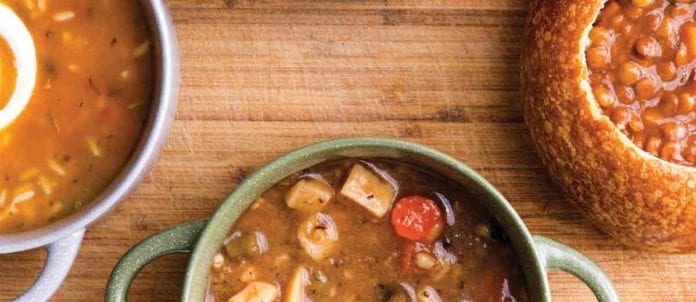The soup-and-sandwich combo has become a mainstay in the foodservice world. Some see it as a healthier option to heavier fast-food offerings, while others see a chance to explore different flavours and cultures. Others still have a hankering for classic combinations that bring back fond memories of family lunches.
Though soups and sandwiches may seem like pedestrian menu items, they represent a wealth of opportunities for operators to apply their creative talents, whether they’re putting a new spin on a classic chicken-noodle soup or adding an ethnic flair to a pork sandwich.
A SOUP FOR ALL SEASONS
The seasonal aspect of soup makes it an interesting menu offering. “Naturally, soup gains popularity in the fall and winter. When it’s a cold and rainy or snowy day, sales skyrocket,” says Tim Cuff, chef consultant with The Fifteen Group — a Vancouver-based restaurant-consultancy company.
Soup has been a core business for Soupesoup in Montreal since it opened its doors 16 years ago. The restaurant offers a rotation of five to six soup options daily and the menu is updated seasonally based on the ingredients available, says Martin Trudel, president. Not surprisingly, 90 per cent of its sales take place during the lunch period. “Lunch is a time of day when people can disconnect and really enjoy a meal, but the time factor is important. They want a fast-paced option that’s healthy, rather than going for fast food or sitting an hour-and-a-half in a restaurant,” Trudel says.
Soup is also the perfect way to balance the nutritional factor in meal planning, he adds. “You can pair a vegetable soup with a ham-and-cheese sandwich; or a hearty beef soup with a salad to get your protein.” With 200 soup recipes in Soupesoup’s library, there’s plenty of diversity. “People who come back several times want variety. They like to travel within a lunch menu and are looking for flavours of the world. There are a lot of Asian and Indian influences in what we do.”
In the case of high-end operators, soups are made from scratch and carefully considered, McDowell says. “Full-service operations are expected to have two soups. Upscale-casual [feature] more, since soup is often a first-course option.”
Even with a classic such as chicken noodle, an upscale operator might make the pasta from scratch or make interesting shapes. “People want to know you made it,” says McDowell. At the Drake Commissary in Toronto, for example, chef de cuisine Jonas Grupiljonas’ chicken-noodle soup uses different flours — such as rye and caraway — for the noodles. For the most part, he prefers to prepare borscht and sour soups because they are more complex in flavour.
THE SUM OF ITS PARTS
McDowell says the industry is seeing more well-thought-out, original sandwiches. But the appeal of sandwiches, beyond the taste and healthiness over other fast-food choices, is simple economics. “Customers don’t want to spend $30 on a full entrée at lunchtime. A sandwich made with freshly baked bread is always trending.” He notes flavours such as mint, cilantro and rosemary are “hot flavours right now. People want [food] that pops with fresh herbs, aioli or a vinaigrette.”
“In the past, sandwiches were just delicious and cheap. Now, they also need to be nourishing and healthy,” Cuff says. As such, top-quality ingredients are an integral part of the equation.
When planning a sandwich menu, Cuff recommends operators look to the right sources, starting with the bread. “Find a good baker that makes good bread. That’s number-1.” A growing number of operators are looking for more traditional breads that use ancient grains and less-processed flours. “If you can get millet, flax, buckwheat or sunflower seeds, you get a great flavour profile and texture,” Cuff says.
What goes on that bread is of paramount importance. When considering meat choices, Cuff suggests whole cuts. “If you have a whole chicken or beef-chuck roast you can get better flavour, moisture and texture.” Slow roasting is a great option for secondary cuts, he adds. “You get really flavourful meat that’s tender.” Cuff also stresses the importance of a good spread to hold it all together. “A garlic aioli is great because you can always do something unique with it,” he says.
But, warns chef Dan Olson, of Railtown Café in Vancouver, operators have to be careful not to reinvent the wheel when it comes to sandwiches. “We don’t like to get too crazy. We focus on the ingredients first. “People are more educated when it comes to food and appreciate the quality of products where nothing is processed.”
His menu is based on six proteins — beef, brisket, pork, chicken, turkey and salmon. He also offers a weekly special that plays on classics, such as an upscale version of Philly cheesesteak, meatball or Cubano sandwiches. The biggest seller, by far, is the chicken club on focaccia, he reports. “We also get a ton of demand for vegetarian and vegan sandwiches.”
Every product is prepared in-house — from the bread and meat to the toppings and condiments. “We use our own rye bread for our Reuben, sourdough for smoked turkey and multi-grain for our salmon salad. The only thing we don’t make in-house is the gluten-free bread.”
Railtown even makes its own condiments, including whole grain mustards. “We look for the perfect richness, sweetness and acidity to complement proteins without making the condiment the star attraction. Having 15 ingredients on a plate gets confusing.”
THE ART OF THE SANDWICH
Sandwich making has become an art form, says Soly Ziv, president of Toronto-based Pumpernickel’s. “It’s all about artisanal sandwiches made with high-quality bread and ingredients.”
In response, Pumpernickel’s has introduced a line of slow-cooked roast beef and turkey sandwiches, as well as a porchetta sandwich and a selection of gourmet breakfast sandwiches. “These are becoming very popular, even beyond the breakfast hour,” Ziv says. “McDonald’s has already been doing it. Others, like us, are upscaling them with ingredients like truffle and basil and fresh bread.”
Wraps are maintaining popularity, particularly on the catering side, he adds. “People don’t want messy food. Wraps are very neat compared to holding a big sandwich.”
Felix Zhou, chef and co-owner of Heritage Asian Eatery in Vancouver, is doing his own variation on a traditional theme with his French/Asian-inspired bao sandwiches. “What’s really in right now is pork-belly bao with house-made kimchi.” The beauty of a bao, he says, is that it’s easy to hold, lighter in texture and relatively economical. “People don’t want to have salad all the time. [Bao] is tasty, reasonably priced and offers good value. And you can pull flavours from anywhere to make them.”
PUTTING IT ALL TOGETHER
McDowell believes simplicity is key when putting a menu together. “We recommend a 10-to-25 item menu; keep within those bounds. That number includes soups and sandwiches. Then you can put your focus on putting out high-quality products.”
In addition, says Cuff, operators need to think carefully about the pairings when planning menus. “If you are offering a grilled-cheese sandwich, you have to have a tomato soup. It’s like a marriage. You can’t have one without the other.”
He adds that quick-service restaurants tend to go for something familiar but interesting. “It has to be tasty. Quick-serve shouldn’t mean cheap; it should mean quality that can be delivered fast. You want good-quality tomatoes, garlic, onions and cream rather than a can of tomatoes in a blender. Anything you put in your mouth should have layers of flavour.”
Volume 50 Number 8
Written by Denise Deveau


















